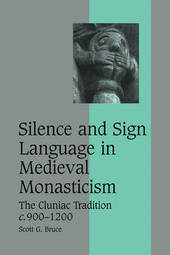
|
Silence and Sign Language in Medieval Monasticism: The Cluniac Tradition, c.900-1200
Paperback / softback
Main Details
| Title |
Silence and Sign Language in Medieval Monasticism: The Cluniac Tradition, c.900-1200
|
| Authors and Contributors |
By (author) Scott G. Bruce
|
| Series | Cambridge Studies in Medieval Life and Thought: Fourth Series |
|---|
| Physical Properties |
| Format:Paperback / softback | | Pages:228 | | Dimensions(mm): Height 229,Width 152 |
|
| Category/Genre | Sign languages, Braille and other linguistic communication |
|---|
| ISBN/Barcode |
9780521123938
|
| Classifications | Dewey:419.1 |
|---|
| Audience | | Postgraduate, Research & Scholarly | |
|---|
| Illustrations |
Worked examples or Exercises
|
|
Publishing Details |
| Publisher |
Cambridge University Press
|
| Imprint |
Cambridge University Press
|
| Publication Date |
17 December 2009 |
| Publication Country |
United Kingdom
|
Description
Silence and Sign Language in Medieval Monasticism explores the rationales for religious silence in early medieval abbeys and the use of nonverbal forms of communication among monks when rules of silence forbade them from speaking. After examining the spiritual benefits of personal silence as a form of protection against the perils of sinful discourse in early monastic thought, this work shows how the monks of the Abbey of Cluny (founded in 910 in Burgundy) were the first to employ a silent language of meaning-specific hand signs that allowed them to convey precise information without recourse to spoken words. Scott Bruce discusses the linguistic character of the Cluniac sign language, its central role in the training of novices, the precautions taken to prevent its abuse, and the widespread adoption of this custom in other abbeys throughout Europe, which resulted in the creation of regionally specific idioms of this silent language.
Author Biography
SCOTT G. BRUCE is Assistant Professor of Medieval History at the University of Colorado at Boulder.
Reviews'... Bruce is an informative and insightful guide. ... [an] instructive and perceptive study.' Journal of Ecclesiastical History 'This is a smart and lively book. A brief summary cannot discuss at length its important sub-themes, including the pedagogical and acculturating purposes of the Cluniac lexicon and its variations, the essential unity underlying apparently diverse developments in religious life in the eleventh and twelfth centuries, and the deep influence of Cluniac practice across Europe.' The American Historical Review
|